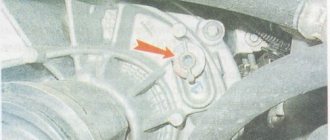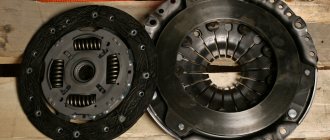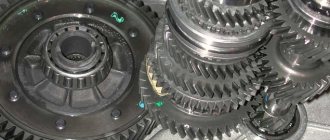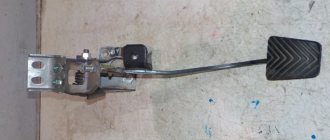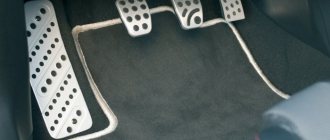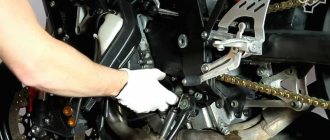The clutch on an automatic transmission performs the same role as on a manual transmission. This function allows you to change gears. Only on an automatic transmission the clutch procedure and design differ from a mechanical one.
But there are other types of boxes. Do you know whether there is a clutch on a variator or robot and how it differs from an automatic transmission?
Write your answer in the comments.
Does the automatic have a clutch?
Do you know that in an automatic transmission the work of the first pedal is performed by a torque converter? This model appeared at the beginning of the twentieth century. The first automatic transmission manufacturer was the Ford plant.
Attention! The first gearbox, although half mechanical, had a planetary gearset built into it.
The second attempt to make full-fledged automatic transmissions occurred in the twenties of the twentieth century. The development of automatic machines on servo drives was carried out by General Motors. They were semi-automatic, but the first step in automating the driver's work in the car had been taken.
And the first fully automatic machine was a box called “Koktal”. The automatic transmission was unreliable and constantly broke down. Chrysler took over the development. He introduced a torque converter and a fluid coupling into the automatic machine. As a result, in the forties a full-fledged automatic gearbox appeared.
And the electronic control unit was added in the eighties. At the same time, four- and five-speed automatic transmissions appeared. The ECU on automatic machines helped to save vehicle fuel consumption.
Nowadays, almost all foreign cars use an automatic transmission. This happens because an automatic transmission has a number of advantages over a manual transmission:
- simplicity and comfort of control for newbie car enthusiasts as well. Because there is no clutch pedal. If with a manual transmission, a car owner who recently got behind the wheel could burn out the clutch by keeping his foot on the pedal for a long time. This will not happen with an automatic transmission;
- the engine and other mechanical parts are protected from overloads;
- The automatic transmission has a longer service life than manual transmissions, provided that preventive measures are taken: changing the lubricant, filter, adding oil.
Read
Signs, symptoms and consequences of low oil level in automatic transmission
If you know anything else from the history of slot machines, you can add it in the comments. And newbie car enthusiasts may not doubt the question of whether there is a clutch on the machine. Next we will talk more about the types of clutches that are used on manual and automatic transmissions.
Types of drive system
What transmission drive systems do you know? Many people will now name only the mechanical and hydraulic principles. However, there are two more types:
- electric;
- combined.
Let's look at each clutch control principle in the table.
| Drive system | Difference |
| Mechanical | Transmission of force to the release fork via a cable by pressing the pedal |
| Hydraulic | Two cylinders (hydraulic and working) are connected by a high-pressure pipe. The pedal moves the hydraulic rod and presses on the piston at the other end. The piston presses on the oil. The oil is transferred through the tube to the working cylinder. The rod, which is located in the latter, presses on the fork. |
| Electric | Electric motor with cable. The clutch is identical to a mechanical drive |
| Combined | Combined use of the above systems (hydromechanical, for example) |
Types of clutch
In addition to differences between drives, there are differences between types of clutch on an automatic transmission. But there are only two types:
- dry;
- "wet". Or they also call it wet.
In the first, the gearbox clutches operate in an air environment, and in the latter in the transmission fluid.
Attention! The dry type is used on manual transmissions and robotic ones. In an automatic transmission, this work is performed by a torque converter, which is driven by lubricating fluid.
In automatic machines, oil not only plays a passive role as a lubricant, but is also an active substance that causes the torque converter blades to rotate under pressure.
Read
13 inexpensive cars with automatic transmission
How to check the clutch on a car - manual transmission and automatic transmission with your own hands
When buying a car, it is very important to check the functionality of as many components and assemblies as possible. The clutch is one of the most expensive components in a car. It is also recommended to check it when purchasing a used car. Our method, which we will share with you below in the article, is effective and works both on the VAZ Priora and on the KIA Serato, Toyota Corolla, Mazda 3 and other budget cars. Here you will learn how to check the clutch on a manual transmission car.
The clutch is considered an expensive consumable in a car; its price can be put on par with the turbine. Maybe a consumable - that's a high word. But still, on average, a clutch kit lasts 100 thousand km. The clutch kit itself and the work to replace it are not cheap. This is why you should check it thoroughly before purchasing a car.
Clutch structure
The clutch design consists of twelve elements. Each of them plays a follower or lead role. Let's consider only the five main elements and their functionality.
- Basket or pressure plate. It has a round appearance. In it, the car owner will find pressure springs, which are located in the center of the basket. And the dimensions are identical to the dimensions of the flywheel to which they are firmly connected. The driven disk is usually inserted between the flywheel and the platform basket.
- Driven disk. It has a radial base and a round shape. The car owner will find in it friction linings, a clutch that connects this disk and the input shaft of the machine. Damper springs are located around the driven shaft. They help reduce vibrations when changing gears.
- Friction linings are made of carbon or Kevlar threads. They can be found at the base. Fastened to the disc with rivets.
- Release bearing. It consists of a pressure pad on one side. The bearing is located on the input shaft. It is attached to the protective casing. The bearing works due to the influence of the fork on it.
Attention! There are two types of release bearings. Pull and push. The first is installed on cars from the Peugeot company.
Mechanics
As we remember, there are three pedals, if you go from right to left - the first is “gas”, the middle is “brake” and the outermost is “clutch”. In order for you to get going, you need to squeeze the clutch into gear, then releasing this pedal, press on the gas and the car goes. When changing gears, you also need to repeat this procedure.
The design is very simple - if you like, it is based on dry friction of discs. To exaggerate, under the action of its springs, the driven one is rigidly pressed against the driving disk, due to which the car moves. But as soon as you press the pedal, the discs unclench (move away from each other) and you can change gears (up, down, or neutral).
Clutch operation in an automatic transmission
Now you know what the clutch in an automatic or manual transmission consists of. Has anyone seen how this device works in a machine? After all, now the driver does not have a pedal, but the mechanism is still there and continues to work in automatic vehicles.
The torque converter does this job. And now you will learn in detail how the clutch occurs:
- The driver turns the ignition key and starts the engine.
- Transmission fluid gets into the donut. This is what a torque converter is called in mechanics' jargon. It was given this name because it is similar to this bakery product.
- The pump wheel starts moving first. It increases the rotation speed when starting from a stationary vehicle. Oil streams rush to the turbine, which is located between the pump and the reactor wheel.
- This torque is supplied to the wheels of the vehicle. The car starts to move.
- The required speed is reached and the pump and turbine begin to rotate equally. And the oil gets into the reactor. It rotates.
- Now the gas turbine engine becomes a fluid coupling. And when going up the slope, the reactor wheel stops working. Lubricant flows are sent back to the pump.
- The desired speed is reached and the gear is changed.
- The ECU comes into action. It commands the brake band and clutches to stop the downshift. And the increasing pressure oil enters through a special valve and creates switching without loss of power.
- If the speed starts to decrease, then reverse switching occurs.
Read
Why do you need neutral on an automatic transmission, switching and coasting on an automatic transmission?
This is called clutch performance in wet conditions. Oil plays an active role. Therefore, the lubricant must be clean and not burnt.
Attention! I advise changing the lubricant completely after 60,000 kilometers, and doing a partial replacement after 30 thousand km.
The machines have additional operating modes:
- sport;
- winter driving;
- manual control of the box.
But unlike CVTs, automatic transmissions consume a lot of fuel. The boxes weigh a lot, but almost all machines are repairable and have a low cost.
Read
Reviews on the operation and repair of an automatic transmission on a Chevrolet Lacetti
Now let's think about the clutch in a manual transmission. The action takes place in a dry environment via a disc clutch. In a nutshell, the driven disk is pressed tightly against the driving disk, and the machine moves forward. Strong pressing occurs due to springs located in the basket. What happens next is:
- The driver presses the clutch pedal. The pressure bearing is pressed.
- The discs are unclenched. The driver can change the speed.
- The pedal is released. The vehicle continues to move in the selected gear.
This is how mechanics work. This method is used on robots, but under the electronic control of an on-board computer.
Let's sum it up
As you can see, the automatic transmission also has a clutch, but this mechanism is very different from the dry disc clutch on a manual transmission or robotic gearbox. In fact, the automatic transmission clutch is the torque converter.
It is also important to understand that the transmission oil in an automatic transmission is the liquid through which torque is transmitted from the drive turbine to the driven one. The oil in the gas turbine engine gets very hot, and as it ages, the properties of the transmission fluid change. For this reason, the oil in the automatic transmission must be changed in a timely manner, and its level and condition must be constantly monitored.
Finally, we note that the torque converter is also installed on the CVT variator. Although the design and principle of operation of the variator and automatic transmission are different, on a CVT the torque converter also serves as a clutch, that is, torque is transmitted from the internal combustion engine to the gearbox through the transmission oil due to the rotation of the turbines.
Why the automatic transmission kicks, the automatic transmission jerks when changing gears, jerks, jerks and impacts occur in the automatic transmission: the main reasons.
Automatic transmission slipping when changing gears: the main reasons why an automatic transmission slips. Box diagnostics, troubleshooting.
Torque converter in an automatic transmission: operating principle and main malfunctions. Signs of problems with the torque converter of an automatic transmission, repair of gas turbine engines.
The automatic transmission jerks: the main causes of jerks, kicks, and shocks in the automatic transmission. Diagnostics of faults, tips and recommendations.
A jolt in the automatic transmission, the appearance of jerks when shifting gears of the automatic transmission, jolts of the automatic transmission in place: the main reasons for such malfunctions of the automatic transmission.
The main sensors in an automatic transmission: the purpose and operating principle of automatic transmission sensors. Malfunctions of automatic transmission sensors, signs.
Clutch operation in robotic gearboxes
A robotic gearbox differs from an automatic transmission in structure. In design, it is similar to a mechanical box, and is controlled not by a person, but by a computer. However, it consumes less fuel than a classic automatic. Has dry clutch and wet clutch.
Dry clutch
Switching occurs via a servo drive. It is called an actuator. They come in two types:
- electric;
- hydraulic.
The operating principle of a dry clutch is as follows:
- The ECU receives information about the engine rotation speed.
- The signal is sent to the servo drive.
- The transmission mechanism disconnects the engine from the manual transmission.
- The ECU determines whether the speed is decreasing or increasing.
- Accordingly, the car either increases acceleration or decreases it.
This is how a dry clutch works on robots. Difficulties arise when using a robotic gearbox with a dry clutch. It is impossible to move smoothly on it. But this disadvantage is compensated by fuel efficiency.
Wet clutch
The principle of operation of a wet clutch on a manual transmission:
- The motor starts to rotate faster.
- The lubricant flows from the pump to the distributor.
- The pressure is rising. When the optimal level is reached, the distributor releases pressure to the actuator.
- The last one squeezes the clutch.
- The gear changes. And the engine is automatically disconnected from the box.
Read
How to operate an automatic transmission
This is how a wet clutch works on robotic automatic machines.
Attention! There are robotic boxes that contain two clutches. One of them works with transmissions on odd numbers, the other on even numbers. This type of clutch is soft compared to a conventional robot. Dual clutches can be found on sports cars.
Clutch in the variator
You know that the clutch is also available on the CVT gearbox. Only it is performed by a torque converter, just like on an automatic transmission. Additionally, it is assisted by electronic devices and sensors. They transmit information about engine speed, oil pressure, and wheel rotation. Based on this information, the wedges move apart or move to provide an increase or decrease in speed.
The classic variator smoothly switches speeds. This is what distinguishes it from a machine gun. The driver can determine smooth shifting by reading the tachometer. If on an automatic the needle shoots up sharply, then on a variator it happens smoothly.
Torus, chain and V-belt variators operate on this principle. The only negative that drivers do not like is the slow acceleration of the car.
What type of box is on your car? Write in the comments.
How to check pedal free play?
The clutch pedal has a certain free play value. After some time or due to the influence of certain factors, this value may increase. First, it is necessary to determine this value at the moment, and if it deviates from the permissible norm, it is necessary to carry out appropriate repairs. Many cars are equipped with an adjustable clutch system, and you can adjust it either yourself or with the help of a specialist. If the car has only had minor mileage on its basket, then this repair method can solve the problems, but if it is serious and the clutch has already been adjusted, then replacing the discs or basket is recommended. Repairs and adjustments should be made when the first signs of a problem are detected, as this will save money on expensive repairs.
Source
